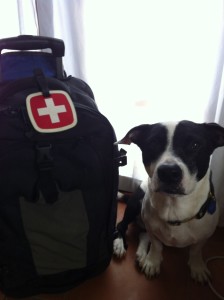5 Myths About Canine Separation Anxiety
 Your neighbors are upset by constant barking and howling in your absence and have contacted you repeatedly. You now need to replace your door due to damage caused from scratching and biting by your dog. When you are preparing to leave the house, your dog paces, pants, and whines uncontrollably. If any of these scenarios sound familiar you may be dealing with a separation anxiety situation.
Your neighbors are upset by constant barking and howling in your absence and have contacted you repeatedly. You now need to replace your door due to damage caused from scratching and biting by your dog. When you are preparing to leave the house, your dog paces, pants, and whines uncontrollably. If any of these scenarios sound familiar you may be dealing with a separation anxiety situation.
Sadly, separation anxiety normally does not just resolve itself nor will your dog just “get over it.” A methodical, specific protocol is what is required to help your dog remain below threshold and slowly gain the confidence and comfort level to be able to be by themselves.
The following are five myths that folks may have come across in regard to treating separation anxiety.
- DOGS: Only in a small number of cases is a separation anxiety dog helped with the addition of another dog to the family. If you suspect that a second animal may help your pup, it may be best to work with a trainer to briefly foster or try introducing the second dog to the situation. Better yet, is to work with a trainer on the specific separation anxiety before adding another dog into the household.
- COLLARS: A shock or citronella spray collar may briefly stop the barking, however any type of aversive collars, of which these are two, have the added possible side effects of apathy, escape/avoidance, aggression, and generalized fear. Thus, to actually resolve the separation anxiety issue, it is best to get at the actual anxiety problem, rather than potentially creating new issues with “quick fix” collars.
- AVOIDANCE: Separation Anxiety is an issue which is very unlikely to resolve on its own. Dogs with SA are in an extreme state of agitation-akin to a person suffering from a panic attack-which won’t just go away with repeated exposure and time. Instead, working on a well planned protocol with patience and consistency is the key to long-lasting behavioral change.
- EXERCISE: Although exercise plays a vital role in your dog’s healthy lifestyle, exhausting your dog is no substitute for a carefully planned protocol of counter conditioning and desensitization.
- FOOD: While food puzzles have their place in a larger program to treat separation anxiety, teaching the dog to be comfortable alone is different than teaching the dog to eat alone. Once the food is gone, the anxiety remains. A better plan is to use food puzzles to create positive associations as part of a larger protocol to help your dog build confidence while alone at home.
For additional information and/or to schedule a consult to discuss options on receiving help from a professional, contact PAW-Positive Animal Wellness.
